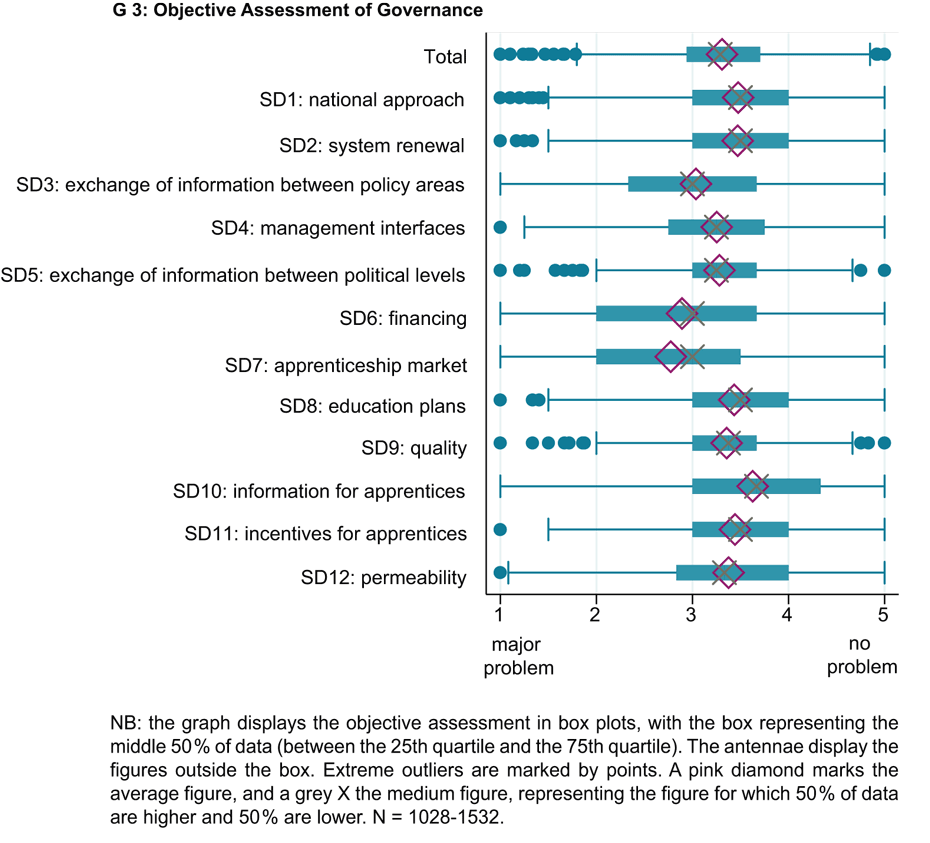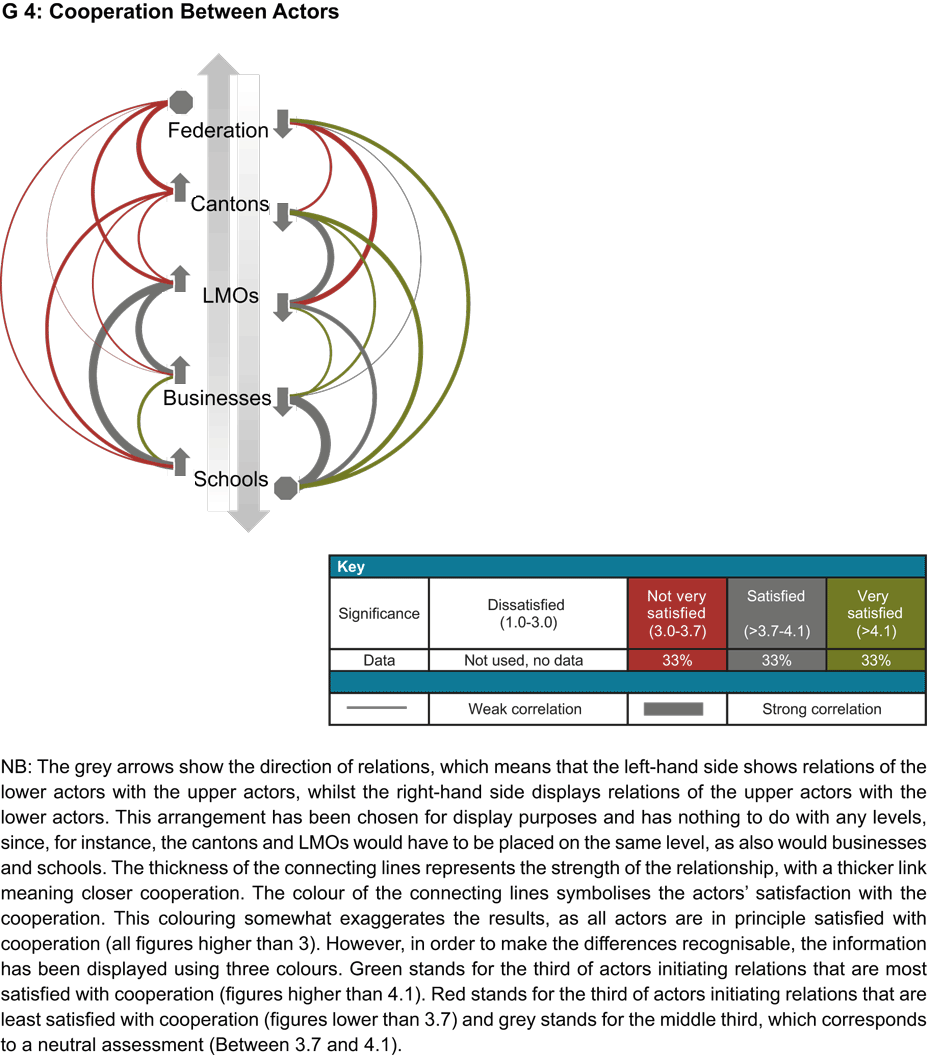How Well do Players in the Vocational Training Sector Work Together?
- KOF Bulletin
- Vocational Education and Training
In a new study, KOF has investigated the cooperation between the different actors in the Swiss education system. The results show that they are generally satisfied with how they collaborate. However, there is scope for improvement as regards cooperation with the federal authorities.

The KOF research division Education Systems has concluded an assessment of the management of the Swiss system of vocational training. The study commissioned by the Swiss State Secretariat for Education, Research and Innovation (SERI) focused on the following questions:
- How good is governance1 within the Swiss vocational training system?
- How good is the governance of system interfaces?
SERI identifies the improvement of the systemic knowledge of vocational training actors at national level as an important governance issue, including these actors’ awareness of their own role and significance for the overall system. It is envisaged that this will establish where and whose systemic knowledge is good, and also where there is potential for improvement.
The survey was carried out in both German and French in January 2019 and was addressed to selected actors in the Swiss vocational training sector. Overall, 2129 people participated, including representatives from all cantons and all sectors of the economy.
Association partners are relatively satisfied with the Swiss system
The overall individual satisfaction of association partners with the governance of the Swiss vocational training system is relatively high, averaging 3.7 across all participants (on a scale of 1 to 5). Satisfaction with individual management areas averaged between 3.0 (management area SD6: financing) and 3.9 (SD12: permeability). It may thus be presumed that governance is satisfactory overall. There is a lack of international comparative figures, as these surveys have only been carried out in Switzerland until now.
The average figures from an objective, detailed assessment of the twelve management areas (including sub-questions) comprising a vocational training system are slightly lower on average, as is shown by graph 3. Average figures lay between 2.8 and 3.6. Different actors therefore assess individual management areas slightly differently.
Intensive relations between firms and vocational colleges
Cooperation between association partners is the key to a properly functioning vocational training system. Graph 4 shows how satisfied respondents are with cooperation, as well as the intensity of cooperation, with reference to selected network analyses. Cooperation is most intensive between businesses and vocational colleges. It is also apparent how intensively schools cooperate with labour market organisations (LMOs). These relations are graded satisfactory to neutral, which can be considered particularly positive.
Although relations with the federal authorities are not generally very intensive, actors that work with the federal authorities are rather less satisfied. There is some tension in terms of less satisfactory relations between the federal authorities and LMOs, a dynamic which operates in both directions. Action is needed here, as LMOs play a core role within the dual system of vocational training.
Recommended action and outlook
The results suggest the following recommendations for action for the Swiss vocational training system:
- The increased integration of innovative companies involved in research into curriculum and the updating of training ordinances could foster innovation. These companies could for instance be involved in recruiting businesses to sit on a reform commission.
- Compared to other countries, there is scope for improving the way in which association partners provide information about when curriculum changes and amended training ordinances are to take effect, as well as the content of such changes.
- Cooperative relations between business and vocational colleges are particularly intense and should be enhanced by the responsible association partners.
- LMOs should be recognised by their member businesses as key players in the association partnership. They work well together.
- There should be a focus on ensuring cooperative relations between the federal authorities and LMOs. It is evident from survey results that neither side is particularly satisfied with the other. This cooperation should be put on a firmer footing.
The following action is recommended as regards the governance of system interfaces:
- The feasibility of harmonising accreditation for general training throughout Switzerland should be considered with reference to the principle of equality of opportunity.
- The differing significance of formal vocational training qualifications compared to informal tertiary education courses should be discussed.
- From the perspective of participants, it is necessary to put in place procedures for recognising formal and informal qualifications (e.g. attendance of a voluntary course) and informal learning (e.g. work experience).
- Due to the major significance of permeability throughout the Swiss education system, possible improvements to the provision of information concerning this aspect should be examined.
This study concludes that, considering the highly differentiated analysis and the comparatively large number of participants, governance of Swiss vocational training may be regarded as good overall. Cooperation on the basis of vocational training may be regarded as highly intensive and scored as neutral to good. All stakeholder groups have relations with each other of varying intensity.
In general, the association partners regulated by law assess the relationships with the institutions responsible for implementation more positivly than vice versa. This is because they usually have significantly more information. Only the relationship between LMOs and the federal authorities is less satisfactory in the view of participants. It is here that there appears to be the greatest need for action in order to promote more cooperative relations.
1) According to the SERI, this includes the following aspects: examining and adjusting partnership organs with reference to their necessity and efficacy (commissions, panels, groups etc.); strengths of the association partnership in terms of the use of new technologies; simplification of financial flows and improvement of structures of incentives; ensuring financial security (private and public); improving the systemic knowledge of vocational training actors at national level; improving intercantonal cooperation with a view to harmonisation; enhancing the role of partnership organs within the bodies from other areas of education.
An extended version of the article can be found here.
Contact
No database information available

